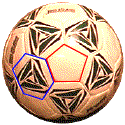


| 
|
 |
|

The story of their discovery is an interesting, and provides a wonderful example of the often unexpected turns that a scientific study can take. In the 1970's, Dr. Kroto was interested in carbon-chain molecules that occur in interstellar space, and in certain carbon rich stars. He and his research group had even detected a few forms such as HC5N, HC7N. However, they still had many questions about how these molecules formed. Dr. Smalley had a system (used for studying silicon and other semiconductors) that used a laser to vaporize materials. In such an apparatus, the conditions are in many ways similar to those in stellar atmospheres. In the mid 1980's, Curl told Smalley of Kroto's interests, and they decided to collaborate, using Smalley's apparatus to see if they could produce molecules of the kind Kroto had been studying. Smalley invited Kroto to Texas, and what they found surprised them, and everyone else in the scientific community.
In general, the term "Buckyball" has been used to describe any roughly spherical molecule built entirely of carbon atoms. C60 was the first to be discovered, but there are many more as well. Since the discovery of C60, many other similar structures have been found. Among the other Buckyballs, are C70, C84, and the list goes on... the largest I have heard reference to is 960! However, it is because of the perfect symmetry of C60 that these materials were named after the engineer, architect, mathematician, and 1960's icon R. Buckminster Fuller, who invented (among other things) the geodesic dome. The scientifically correct name for C60 is "Buckminsterfullerene."
In addition, to balls, other shapes are possible. The first "non-ball"
structures to be found were the "Buckytubes." Often called
carbon nanotubes, these are tubes with a carbon mesh surface and, in some cases, spherical end caps.
The tubes can have bends in them, and several tubes can even be joined. What other possibilities are there? Well, if a tube can be distorted so that the ends touch, a "donut" shape is formed (more technically, a torus). The same distortion can be applied to a carbon nanotube resulting in a carbon nanotorus. Even the Y shaped structure show at the right is possible. Clearly, tubes, tori, etc., cannot be called "balls." The catch-all phrase for all of these structures is "Fullerenes."
These materials turn out to be remarkably strong. Buckyballs smashed into a steel surface at 17,000 miles/hour bounce of undamaged. Of course, it is possible to destroy them. If your browser can handle mpeg movies, have a look at a page that shows simulations of collisions between a C60 and a C240. You can also have a look at some collisions between one C60 and a Si surface. Depending on the energy, the C60 may bounce off or get stuck. There have literally been hundreds of applications suggested for using fullerenes. To see a few, check out the fullerene patent database. C60 would have been surprising in its own right. Then, it was found that some compounds of C60 were superconductors! What sorts of compounds? well, it turns out that if you condense a bunch of C60 on a glass plate it will form a film, the molecules stack up on an fcc lattice, much the way copper atoms stack up in a solid.
Incidentally, Buckyballs are not difficult to make. You can read a very
good, readable account of a buckyball synthesis project by
two undergraduates at Evergreen State College. The end of their page has
links to more Buckyball sites. Or, if you would prefer to
buy
the materials you can do that too. The price for 1 gram of C60 is about $40.
For more information ...
Please mail your responses to Dr. Gavrin.
|
||||||||||||
|
|
||||||||||||